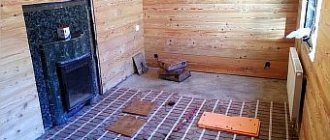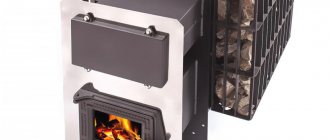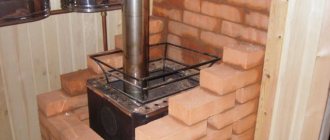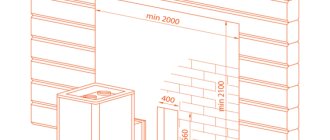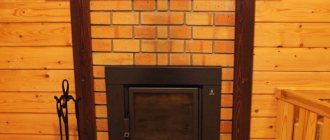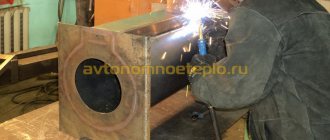There is no bathhouse without a stove, so it must be included in any project. Usually they install a wood-burning stove, which can work as a heater to generate steam in the steam room. The boiler only copes with the heating function, but does not produce steam. If there is little firewood in the region, then they install the lowest-power heater, and compensate for the lack of heat with a boiler.
The sauna stove can be either ready-made or built independently from brick. In any case, finishing of the stove in the bathhouse is necessary. It is required as it protects wooden walls from overheating. You can finish either the stove or the walls, or both. The stove cannot be used without finishing, except in very rare cases when the stove is located in the middle of the room.
Basic options for installing a sauna stove
The sauna stove is installed in accordance with regulated fire safety rules. As a result, several installation options can be distinguished. Everyone decides for themselves which one suits them best:
- Location inside the steam room. As a result, it is quite easy to regulate the temperature by adding firewood right away. However, oxygen burns out quite quickly and humidity must be constantly maintained.
- Installing a stove in a bathhouse with an external firebox. You will need to make a technological hole. But this means cleanliness, space saving and increased safety.
- Stove in a bathhouse with a fuel channel on the street. This significantly saves space, but during vaping it is very inconvenient to add firewood or coal in order to maintain the desired temperature for a long time.
There is no single solution for how to properly install a stove in a bathhouse. It is necessary to evaluate the advantages and disadvantages of each option and choose the optimal solution for a particular situation.
How to install a stove in a bathhouse, at what distance from the wall
The installation of a metal stove in a bathhouse must comply with fire safety rules. The distance from the wall is one of the most important points. The firebox should be placed at a distance of 1 meter from objects, but this rule is quite difficult to comply with. Cladding is often used. Clay or brick is used to insulate materials that can easily catch fire. Let’s assume that the stove is installed in a bathhouse with a distance of 80 cm from the firebox. This distance must be maintained.
When installing on a wooden floor, it is also necessary to additionally insulate the material. Fire is possible not only from the firebox, but also from hot metal.
Steel case
Steel is also a fire-resistant material. It cannot be left untreated, as it will instantly rust in a bathhouse. When finishing the space around the stove with steel, you need to keep in mind that unlike brick, tiles and stone, steel does not insulate heat at all.
A protective portal around the stove made only of steel will be completely pointless, since it will not be able to fulfill its main task - to protect wooden walls from overheating. In order for this function to be fulfilled, it is necessary to provide a good heat-insulating layer of another material, and then cover it with a facing steel sheet.
To finish the portal around the furnace with steel, it is convenient to use ready-made factory-made elements. Such accessories are made for fireplaces. Without modifications, they are also suitable for a bath.
This heat-insulating separation layer is created from mineralite. Other fire retardant insulation materials can also be used. Simple mineral wool is not suitable, since after getting wet once it shrinks in volume, and this defect cannot be corrected by anything.
The insulation near the stove should not get wet. You need to take care of its waterproofing. Moreover, this waterproofing should only be on the side of the cold wall, but not on the side of the stove.
Steel has a metallic luster. This effect can be used to greatly increase the efficiency of the portal.
If made from uncoated polished stainless steel, it will act as an infrared reflector.
A similar element can very often be seen in electric fireplaces, heating stoves and any other heating devices.
The main difficulty of this solution is the need to use only stainless steel. Compared to ordinary steel, it costs 10 times more, but the total thickness of the sheets for the reflective screen can be small.
Stainless steel perfectly withstands any humidity. It can even be placed in rooms such as a steam room in a bathhouse; the decoration around the stove will be compact and with a modern design. In a steam room, all interior elements are usually made only from wood. Stainless steel would be appropriate next to a metal stove-stove.
Where to install the stove in the bathhouse
Installation of a sauna stove begins with choosing a location for installation. You need to know exactly how remote tanks, external heat exchangers, and connecting pipes are located. There are several basic conditions that are relevant to the requirements of SNiP:
- If there is no insulation of materials that can catch fire, you should maintain a distance of 1 m.
- The installation of sauna stoves must maintain a distance from the ceiling of at least 0.8 if it is plastered and insulated, and without protection it increases to 1.2 m.
- It is necessary to maintain 1.25 m from the firebox to the wall. The hot body itself should be located at a distance of 0.5 m.
- The partition for the outlet of the channel-sleeve must be covered with fire protection.
Based on these rules, you can individually decide how the installation will take place and choose the optimal safe place for it.
Recommendations for choosing a boiler for a bath
There are several basic criteria to consider in order to choose the right boiler. These include the following factors:
- Ability to maintain temperature stably;
- The area of the room to be heated;
- Easy installation and the ability to install it yourself;
- Safety, in particular the type of fuel must be taken into account.
It is imperative to focus on these basic features so that construction and installation, as well as operation, do not cause additional problems.
Installation base
Installing a stove in a bathhouse begins with the design of the base for it. It is worth considering that this is hot metal, which means you will need to shield the floors. To do this, you can use a simple concrete screed or a special base that is fire resistant.
It is important to consider that the boiler must be installed in a bathhouse on a durable surface. A structure loaded with firewood or other fuel, along with stones for steam, is quite heavy. When installed on wood, it will gradually be pressed and deformed.
Sauna stove made from a pipe or an old cylinder
The ideal material for production is special boiler steel. However, there is an opportunity to save money if you use cheaper materials. In the case when you plan to take a pipe or an old cylinder, the water tank should be placed above the firebox. It is important to take into account that the thickness of the metal cannot be less than 1 cm, otherwise the use of such material is unsafe.
Choosing the type and size of foundation for the furnace
Installing a stove in a bathhouse with your own hands begins with organizing the foundation. Based on construction norms and rules, several options for installing the base can be distinguished:
- Installation can take place on a monolithic reinforced base. It is not part of the structure, but is laid lower than the soil freezing line.
- A pile-slab base is an ideal option if you plan to install a stove in a bathhouse on moving ground. It will provide stability and security.
- A foundation with a slight depth can become one with the main foundation. This will allow you to decide how to install the stove in the bathhouse from the dressing room and ensure its stability even on moving soil.
It is worth considering its size and location, everyone determines it for themselves. The dimensions of the foundations can be different and are calculated after it has been decided how to install the sauna stove and what it will be like.
What does the boiler consist of?
Before choosing a ready-made boiler for a wood-burning sauna or its design for construction, you need to familiarize yourself with the internal structure of the system and its components. The overall efficiency of the design depends on the coordinated work of each component with the others.
The following elements are necessarily present in the scheme of homemade boilers for a wood-burning bath:
- The base part is a heater. It promotes the accumulation of heat generated by the system. The duration of retention depends on the total volume of the stone fill capable of retaining the thermal energy generated by the firewood.
- Central chimney. Its basis is a vertical pipe through which light combustion products are discharged. It also generates traction, ensuring the circulation of air currents.
- Boilers for wood-fired saunas in Voronezh, Orel, Samara or another city cannot do without a water heat exchanger. Its function is to heat water for later use.
- A passage tunnel with a small door will allow you to heat wood-fired sauna boilers, the price of which depends on the design, from the dressing room or from an adjacent room. This door is often made of heat-resistant glass.
- Firebox (firebox), the area in which firewood or other available solid fuel is heated. In this zone, heat is released from combustion products. The lower part is equipped with a grate of grates on which fuel is placed for various types, including cast iron boilers for wood-fired saunas. You will need to mount the door opposite the firebox, and also form bevels to automatically roll off combustion residues.
- In the lower part, the boilers of wood-burning baths (photos are presented on the page) have an ash pit. They are located under the grate and serve to collect burnt ash falling from the firebox.
Each do-it-yourself water boiler for a wood-fired sauna may differ from its analogues in the structural arrangement of individual elements. At the same time, dimensional parameters affect its performance.
Preparing a wooden floor for stove installation
Often this structure is a log house. That is why great attention should be paid to the question of how to properly install a stove in a bathhouse on a wooden floor. To do this, you need to undergo a little preparation:
- Outline the location, decide on a place for it. It is necessary to provide a margin of up to 10 cm around the perimeter.
- The base can be a mineral slab; you need to cut a suitable base from it. Then it is fixed to the floor; you can use simple self-tapping screws.
- It is necessary to build horizontal brickwork, which will necessarily be supported by fire-resistant mortar.
- The last layer will be porcelain stoneware, which is attached using glue that can withstand impressive temperatures.
Installing a cast iron stove in a bathhouse always requires a similar approach. Even lighter models can push through the floor. With the help of a well-designed foundation, the durability, safety and reliability of the structure will be ensured.
Safe installation standards
To decide how to install a stove in a bathhouse, you must study fire safety standards. They are easy to follow, provide safety and can truly save not only property, but also lives. It is worth highlighting several basic standards:
- Be sure to maintain the specified distance around the perimeter, as well as from the ceiling.
- It is advisable to treat nearby walls and objects with fire protection and not to place flammable objects nearby.
- Prepare the base or foundation to protect against fire.
If all rules and regulations are observed, installing a sauna stove in a wooden bathhouse is truly safe.
Decorative plaster
Plaster for stoves began to be used relatively recently. Indeed, a good stove does not need to be plastered. It is made either of high-quality brick, which in itself looks decorative, or of metal, which also does not need plaster.
In this case, we are not talking about plastering the stove itself, but about creating a protective separating layer of plaster between the walls and the stove. Plaster is quite suitable here.
Finishing the walls in the bathhouse around the stove with decorative plaster is especially often done when the stove is not placed in a steam room.
In this case, the requirements for moisture resistance are much lower.
Base structure
The rules for installing a stove in a bathhouse require a careful approach to arranging the base. To do this, you will need to create a special pillow, which is especially important for wooden floors. It is convenient if during construction the foundation was immediately laid in a designated place. Or the place where the unit will be is initially marked.
Installing a stove in a bathhouse with your own hands begins with the pillow. An excellent base would be a mineral slab, which will ensure a stable position. Then continues with the creation of the foundation. This is brickwork with fire-resistant mortar, which is located horizontally. Step-by-step instructions involve attaching porcelain tiles, which can easily withstand high temperatures. This is the most popular pillow option.
View this publication on Instagram
Publication from the Grigoriev Workshop (@masterskaiagrigorevyh)
Calculating the weight of the furnace to select a base
To understand how to install a boiler in a bathhouse, as well as prepare a podium for the stove in a bathhouse, you need to calculate its weight. To do this, you need to find out the weight of the material and structure, add about 20-30 kg. This is the approximate weight of stones and firewood with a small margin. After this, the installation of the sauna stove and chimney begins.
Preparing the wooden base
If there is a wooden floor, the arrangement must begin from the base. These can be different options:
- Installation takes place on a brickwork pad.
- We are thinking about how to install a boiler in a bathhouse on a pile-grillage foundation.
- A shallow, integral base is used.
Additionally, it would be a good idea to use fireproof protection. Its role is played by a steel sheet or porcelain stoneware slab. With such a foundation, it’s easy to figure out how to install an iron stove in a bathhouse and maintain safety.
Review of the best models
The market offers wood-burning sauna stoves with tanks from both domestic and foreign manufacturers. Let's review the best models that have earned customer recognition.
| Category | Name | price, rub. |
| The best foreign boilers for wood-fired saunas with a tank | Harvia 20 ES Pro S | 39000 |
| HARVIA 36 DUO | 89000 | |
| Kastor Karhu 18 PK ES | 49000 | |
| The best Russian boilers for wood-fired saunas with a tank | Taman 10 TB | 12000 |
| Ermak 12 | 11900 | |
| Varvara Polenitsa | 18000 | |
| Volcano Elbrus 26 Standard | 24000 |
Wood stove installation
In this case, it is quite easy to figure out how to properly install the stove in the bathhouse. It is enough to mount the structure on the prepared base and remove the chimney. However, installing a boiler in a bathhouse with your own hands has some subtleties. It is worth dwelling on them in detail. In particular, this concerns the base and how to ensure the safety of the firebox.
Rules for laying an opening around the firebox
Installation of a stove in a steam room must be accompanied by the filling of an opening around the firebox. Be sure to leave small gaps so that the heating is not too high.
To lay it down, you should understand the algorithm of actions, and then line the firebox with ceramic bricks. This will ensure compliance with all safety measures. Installing a wood-burning stove in a bathhouse requires careful attention to fire safety.
View this post on Instagram
Publication from BANI




